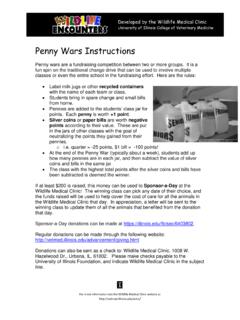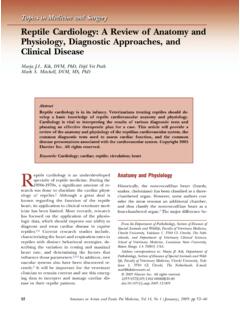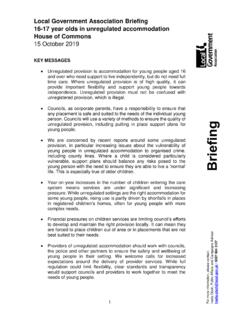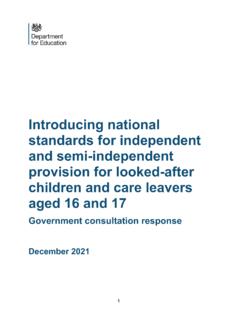Transcription of When the Insulin Isn’t Working: II. Management of the ...
1 When the Insulin Isn t working : II. Management of the Insulin - resistant Patient Marcella Ridgway, VMD, MS, DACVIM (SAIM) University of Illinois College of Veterinary Medicine Urbana, IL Insulin resistance (IR) is usually considered in patients with diabetes mellitus (DM) which do not show the expected response to exogenously administered Insulin , manifesting as persistence of hyperglycemia and persistence of clinical signs suggesting Insulin ineffectiveness.
2 In these patients which do not show satisfactory response to Insulin , it is important to address ALL of the many factors, including IR, which may impair the patient s apparent response to treatment. In fact, factors OTHER than IR are more common causes of poor glycemic control in the initial months of treatment. First, it is critical that, at the time of initial diagnosis of DM, the patient is fully assessed for the presence of other related or unrelated abnormalities that may impact response to treatment. A thorough medication history is important since administration of some drugs (corticosteroids, other steroid hormones, cyclosporine), including topical preparations, may interfere with response to Insulin .
3 Medications which other animals or humans in the household are receiving and to which the diabetic may accidentally be exposed must also be addressed, especially if, after beginning Insulin therapy, the patient is not responding to treatment as expected. Identification of co-morbidities (dental disease, renal disease, cardiac disease) and conditions commonly developing as a consequence of the diabetic condition (urinary tract infection, hypertension) must be identified and resolved or managed to the degree possible. Any source of infection or inflammation may affect Insulin responsiveness.
4 In deciding on the initial Insulin type, dose and frequency of administration, it is important to recognize that recommended starting doses for the various Insulin types are expected to be a starting point, erring on the safer side of Insulin underdosage, and that adjustments upwards are expected. Owners should be fully advised of this in addition to being carefully schooled on proper handling and administration of Insulin and at-home monitoring of the patient. Additionally, it is VITAL to understand that hyperglycemia itself, which obviously will be present in the newly-diagnosed diabetic, causes impaired Insulin response, a phenomenon known as glucose toxicity.
5 The presence of high circulating glucose levels suppresses beta cell function (further suppresses release of any endogenous Insulin ) and induces IR in peripheral tissues, reducing Insulin -stimulated glucose uptake. When Insulin administration is initiated, it takes time for beta cells and peripheral tissues to fully respond to a particular dose of Insulin (until the administration of Insulin begins to correct the hyperglycemia, removing its suppressive effects). THIS IS WHY WE DON T CONTINUE INCREASING THE Insulin DOSE IN THE FIRST 2 WEEKS OF TREATMENT (we may reduce the dose if hypoglycemia occurs but DO NOT adjust the dose upward because of persistent hyperglycemia until the patient has been on that particular dose of Insulin for at least 2 weeks).
6 It is important to realize that sustained hyperglycemia in this period is not unexpected and does not indicate a need for extensive diagnostics to address IR. Another factor to consider in patients not showing expected control is the manner in which they are being monitored and factors other than IR that may impact monitored parameters. Spot-check glucose measurements are not adequate for monitoring DM except to identify hypoglycemia. Even in more accurate assessments of response, such as serial blood glucose curves, we know that results vary significantly even on consecutive days in the same animal with the same dose of Insulin .
7 We need to acknowledge that there will be some day-to-day variation in diabetic control due to variations in how the Insulin is administered and absorbed; total dietary intake and rate of absorption; dietary indiscretions; amount of exercise; and stress, especially in cats. Fructosamine levels may be misleading in patients with other processes impacting serum protein turnover (relatively decreased levels in hyperthyroidism, protein-losing enteropathy/nephropathy) or in patients experiencing a Somogyi response due to Insulin overdosage (may have normal, slightly elevated or markedly elevated fructosamine level).
8 Once Insulin therapy has been appropriately initiated and serial q2week increases in the dose +/- frequency (if initially given q24h with intermediate-acting Insulin type) Insulin have failed to achieve expected glycemic control, the possibility of IR should be addressed as follows: $ Is it really Insulin resistance or are owners not giving the Insulin properly? (Check Insulin expiration, WATCH owners draw and administer Insulin ) $ Is diluted Insulin being used? (Switch to non-diluted) $ Is it impaired Insulin absorption? (In many of the diabetic animals referred for poor glycemic control, owners are administering Insulin improperly in the nape of the neck rather than in varying sites on the lateral thorax.)
9 $ Is it underdosage or inadequate duration of the Insulin type? $ Is it Insulin overdosage? ( Insulin -induced hyperglycemia - Somogyi phenomenon - can produce the appearance of IR or actual IR.) The possibility of a Somogyi phenomenon should be considered in ANY poorly-regulated diabetic regardless of the Insulin dose or fructosamine level. Affected animals will show the same clinical signs as Insulin underdosage although the underlying problem is life-threatening hypoglycemia from Insulin overdosage. Cats are especially susceptible, in part because stress-induced hyperglycemia in this species may complicate accurate assessment of glycemic control.
10 $ Is it progression of beta cell dysfunction? (It is common for DM to get worse , with patients requiring a dose increase 6 months or more after they are initially regulated.) Once these factors have been addressed, the presence of true IR should be considered. Any concurrent infectious, inflammatory, endocrine, renal, cardiac or neoplastic disease can interfere with tissue responsiveness to Insulin by pre-receptor, receptor, post-receptor or multiple mechanisms. A comprehensive evaluation of the poorly-responsive patient is indicated to identify sources of IR.













